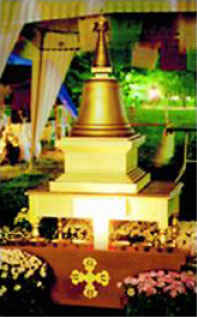Buddhist Stupa
 |
Tibetan Buddhist Stupa Kunzang Palyul Choling (KPC) Temple A Promise of Enlightenment |
A Stupa, or “Chorten” in Tibetan, which means "the basis of offering", can be described as a “Spiritual Monument”. It is a symbol of enlightened mind, (the awakened mind, universal divinity) and the path to its realization. The stupa represents the Buddha's body, his speech and his mind, but most especially his mind and every part shows the path to Enlightenment.
"The visual impact of the stupa on the observer brings a direct experience of inherent wakefulness and dignity. Stupas continue to be built because of their ability to liberate one simply upon seeing their structure" - Chogyam Trungpa Rinpoche
Every stupa contains at the very least a life tree and holy relics:
"When a great teacher passes away, his body is no more, but to indicate that his mind is dwelling forever in an unchanging way in the dharmakaya, one will erect a stupa as a symbol of the mind of the buddhas" - HH Dilgo Khyentse Rinpoche
Shakyamuni, the historical Buddha, had instructed his disciples that after his passing, his body should be cremated and the remains enshrined in a reliquary monument,
or Stupa, as was the custom with regard to the great leaders of the past in India. His purpose for having such monuments erected was not self-aggrandizement but, in the words of the late Lama Govinda, "to remind later generations of the great pioneers of humanity and inspire them to follow their example, to encourage them in their own struggle for liberation from suffering."
When the Buddha's body had been cremated, a dispute arose over whom the remains should belong to, and who, therefore, should have the honor of building the Stupa. A Brahmin named Done interceded in this quarrel and suggested that the remains be divided amongst several parties. The decision was accepted, and as a result eight Stupas were built in different kingdoms of India.
The eightfold division is echoed in the eight types of design still used in Tibetan traditions for the construction of Stupas that enshrine the relics of great teachers. The designs commemorate the eight major events in the life of Shakyamuni, that of his birth, enlightenment, turning of the wheel of Dharma, descent from a heavenly realm, performing of miracles, reconciliation of a split in the Sangha at Bamboo Grove, voluntary prolonging of his life at Vaishali, and his passing away at Kushinagar.
A Stupa is more, however, than a mere reliquary monument. It is an abstract image of the state of Enlightenment attainable by all beings, and the symbolism of this architectural image operates on several different levels simultaneously. On what we may call the level of archetypes, a Stupa incorporates five different geometric shapes pertaining to the five elements of earth, water, fire, air and space, from which the world and all its atoms are composed. Furthermore, the overall shape of a Stupa bears a close resemblance to the shape of a seated Buddha. Merely by viewing such harmoniously balanced images we receive subtle benefit, experienced as a feeling of peace, well-being and wholeness. The various levels of a Stupa also correspond to the various levels on the spiritual path culminating in full Enlightenment.
Stupas also serve as focal points for the widely followed practices of circumambulation and making offerings of light, which are said to create merit, or virtuous karma towards Enlightenment. It is common to see Buddhist practitioners and pilgrims walking clockwise around a central Stupa or lighting candles or butter lamps whilst reciting prayers. This practice helps to keep the image of Enlightenment and all it represents at the centre of one's attention and is therefore said to be very beneficial on both a conscious and sub-conscious level. There are also many benefits of Stupa's mentioned in Buddhist texts. The true value, however, depends on one's motivation and the attitude with which the action is undertaken.
Stupas vary greatly in size. Some are models on a practitioner's altar whilst others, like the Great Stupas of Swayambhu and Boudhanath in Nepal and the Mahabodhi Stupa in Bodhgaya, India attract thousands of pilgrims each day.

